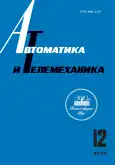Comparison of Distribution Procedures in Blended Finance
- Autores: Shchepkin A.V.1
-
Afiliações:
- Trapeznikov Institute of Control Sciences, Russian Academy of Sciences
- Edição: Nº 12 (2023)
- Páginas: 106-119
- Seção: Topical issue
- URL: https://journals.rcsi.science/0005-2310/article/view/233440
- DOI: https://doi.org/10.31857/S0005231023120097
- EDN: https://elibrary.ru/NGLOEU
- ID: 233440
Citar
Texto integral
Resumo
This paper is devoted to the blended (joint) finance mechanism of a megaproject consisting of several projects. One part of the megaproject budget comes from the megaproject manager and the other part from project contractors. When distributing this budget,
the megaproject manager considers information about the amount of the contractor’s internal funds allocated to project implementation. Project contractors seek to get more funds from the megaproject manager; in turn, the megaproject manager is interested in attracting more funds from project contractors. To achieve this goal, the megaproject manager applies different procedures to distribute the budget. Project contractors use the information reported to the
megaproject manager to increase the funds allocated to them. Straight and reverse priority distribution procedures in the blended finance mechanism are analyzed. A distribution procedure is determined that stimulates project contractors to allocate more of their internal funds to the project in a Nash equilibrium.
Palavras-chave
Sobre autores
A. Shchepkin
Trapeznikov Institute of Control Sciences, Russian Academy of Sciences
Autor responsável pela correspondência
Email: av_shch@mail.ru
Moscow, Russia
Bibliografia
- Бурков В.Н., Новиков Д.А. Как управлять проектами. М.: Синтег, 1997.
- Новиков Д.А., Пузырев С.А., Хорохордина Н.В. Механизмы смешанного финансирования // Системы управления и информационные технологии. 2009. № 2 (20). С. 71-72.
- Бурков В.Н., Буркова И.В., Губко М.В. и др. Механизмы управления: Мультифункциональное учебное пособие; под ред. Д.А. Новикова. Изд. 2-е переработанное и доп. М.: ЛЕНАНД, 2013.
- Иващенко А.А., Колобов Д.В., Новиков Д.А. Механизмы финансирования инновационного развития фирмы. М.: ИПУ РАН, 2005.
- Бурков В.Н. Основы математической теории активных систем. М.: Наука, 1977.
- Бурков В.Н., Коргин Н.А., Новиков Д.А. Введение в теорию управления организационными системами: учебник; под ред. Д.А. Новикова. М.: Книжный дом "ЛИБРОКОМ", 2009.
- Habbel V., Jackson E., Orth M. et al. Evaluating blended finance instruments and mechanisms: Approaches and methods // OECD Development Co-operation Working Papers, Paris, No 101, OECD Publishing, 2021, 65 p.
- Andersen W.O., Basile I., Gotz G. et al. Blended Finance Evaluation: Governance and Methodological Challenges, OECD Development Co-operation Working Papers, Paris, 2019, No 51, OECD Publishing, https://dx.doi.org/10.1787/4c1fc76e-en
- Javier Pereira. Blended Finance: What is it, how it works and how it is used // Oxfam International, Feb. 13 2017, https://www.oxfam.org/en/research/blendedfinance-what-it-how-it-works-and-how-it-used.
- Chainz Christina, Hendrik Hakenes. The politician and his banker - How to efficiently grant state aid // Journal of Public Economics. 2012. V. 96. P. 218-225.
- Chen J. Risk-Adjusted Return, Investopedia, Dec. 20 2018, https://www.investopedia.com/terms/r/riskadjustedreturn.asp.
- Бурков В.Н., Щепкин А.В. Противозатратные механизмы ценообразования при ограничении на сумму цен // Проблемы управления. 2021. № 3. С. 42-49.
Arquivos suplementares









